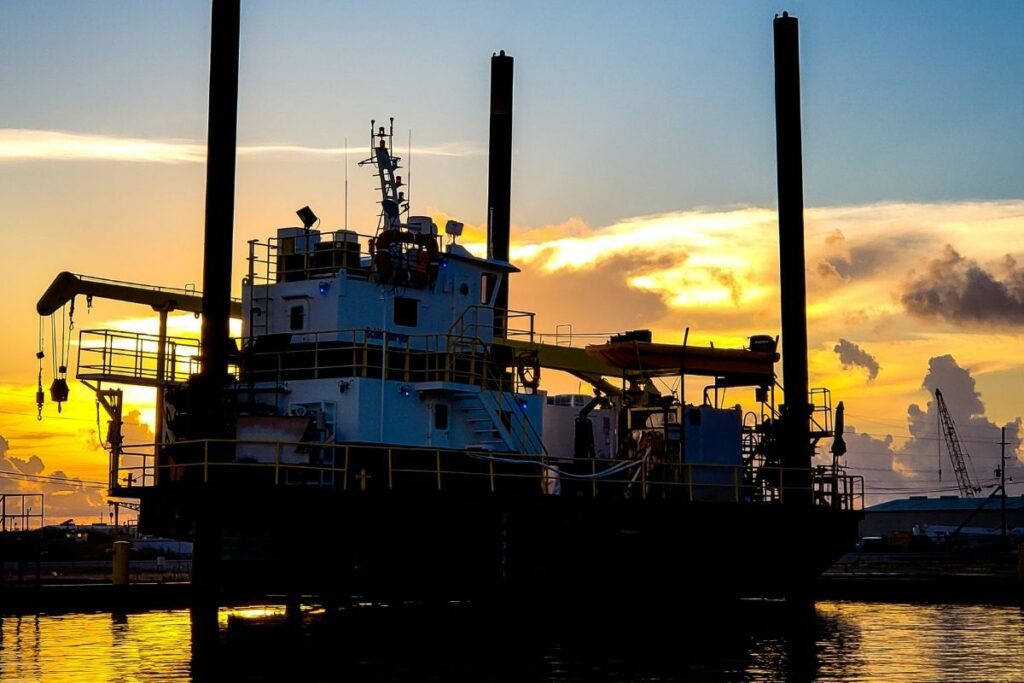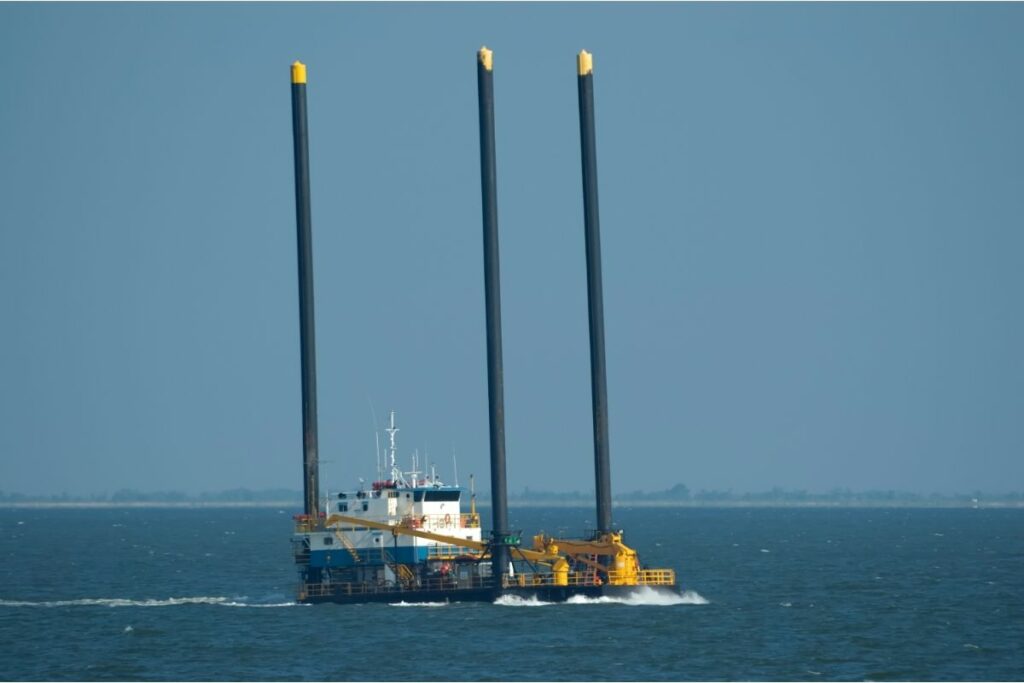There are lots of different types of boats out there, but keeping track of all of them is a pretty daunting task. If you have heard the term ‘lift boat’ before but you aren’t sure what it means or what a lift boat is, then keep on reading.

We are going to take a look at lift boats and what they are, how they work, and where you can find them.
So, let’s jump in!
So, What Is A Lift Boat?
A lift boat is a self-propelled and self-elevating vessel used in support of offshore mineral exploration and production as well as offshore construction. It is designed to stand up out of the water like a platform, providing stability and ease of access to the offshore worksite.
This allows the boat to be used in lots of offshore services and activities, like production and mining. They are primarily used as supporting vessels to serve as a stable platform in the water.
Lift boats are instantly recognizable due to their large, flat, open deck that is often used to store heavy equipment and supplies.
A lot of lift boats will also feature a crane used to lift and move heavy equipment and machinery. It also stands up out of the surface of the water on long, strong legs. Therefore, it looks more like a platform rather than a conventional boat.
Other names for lift boats include jack boats, lift barges, or jack-up barges.
Where Do You Find Lift Boats?
Lift boats are used as service vessels in offshore production, mining, and drilling. This means that these boats are typically owned and used by private companies like oil or construction companies.
However, they can be found near the shore in shallower waters. This is because due to their shape and structure, they do not do well in choppier waters and shallow waters are usually calmer and easier to navigate.
Plus, in order for the lift boat to be able to elevate itself up out of the water, it needs to be able to reach the bottom of the water with the feet of its legs.
Therefore, it’s easier for the lift boat to ‘lift’ itself out of the water because it can extend its legs and connect to the Earth more steadily.
So, due to their convenience but lack of ability to navigate in choppy waters, most lift boats can be found in shallow waters for offshore industry work.
Parts Of A Lift Boat
Because lift boats are so strange and unlike other conventional vessels, they have a lot of different and unique parts that most sailors would not be familiar with.
We are going to jump into their structure and functions to see what makes lift boats so special.
Legs
Most lift boats feature three distinct, columnar legs named pipe legs. They are the parts that are lowered down to the floor and lift the boat up out of the water.
Some lift boats do feature four legs instead of three but these tend to be more costly and do not add that much support or buoyancy. Deciding to leave out the fourth leg makes the lift boat lighter, cheaper to make, and also quicker to build.
Most legs on lift boats are built to be able to work in waters over 220 feet deep. After 220 feet, the legs become less solid and instead use a lattice structure to support the lift boat.
Jacking System
The jacking system of a lift boat is what is used for lifting the vessel up out of the water. This means that is an essential part of the lift boat and without it, a lift boat cannot function properly.

You may be thinking that jacking systems can also be found on other kinds of rigs like jack-up drilling rigs, but the jacking system on a lift boat is unique again.
A traditional jacking system found on other kinds of rigs usually elevates at a rate of about two feet per minute.
However, the speed of the jacking system on a lift boat is far more efficient. They usually work at a speed of about four to six feet per minute. It also lowers the legs to around 14 to 18 feet per minute.
This allows a lift boat to move on and off location at a much quicker pace than other kinds of support vessels.
This is pretty handy because most lift boats are moved around from spot to spot so they have to move pretty quickly.
As well as speed, the jacking systems on lift boats are often more durable and made from sturdier graded materials than on other rigs. This makes them more resilient to shock loads. too.
The Deck
The deck is another iconic feature of a lift boat. It resembles a large, flat platform or a completely open area, so unlike the deck of other boats which usually are raised in sections and feature gunwales or railings.
However, the openness of the deck area on a lift boat allows loading and unloading stores easier, allows the crane and other machinery to work more efficiently, and allows more capacity for storing equipment.
These features are what make a lifeboat so valuable to offshore work and production, and hence why they are so often used by private companies.
Not only that but some lift boats are used to land helicopters as they can provide a wide, flat open space even out at sea.
Propulsion
All lift boats are self-propelled so there is no need for any tug boats to get them in and out of position.
This also means that there is a large propeller attached to the lift boat so it can move around like a normal boat, although it is not suited for open, rough waters.
The Benefits Of Using Lift Boats
Lift boats are a cost-effective way of storing equipment and stores offshore.
They are very advantageous service vessels because they do not require a tug’s assistance as they are self-propelling, they provide workers with a stable flat platform out in the water, and are usually a better option than using jack-up drilling risk or derrick barges.
Because of this, many companies use lift boats for construction and maintenance.
Although they are chiefly used in the United States of the Gulf of Mexico, more and more international markets are beginning to see the advantages of using lift boats and are starting to construct their own fleets.
Conclusion
And that’s everything you need to know about lift boats!
They are very handy vessels as they provide a flat, open and stable area out on large bodies of water, which is great for the construction and maintenance industries.
They are usually used to store equipment, but many people also work on lift boats when constructing bridges or mining under the sea.
They’re very common in the Gulf of Mexico but more and more places are starting to use lift boats, so perhaps you will be able to see one very soon.
- Types of Gas Carriers as per IGC Code – April 22, 2025
- Wind-Assisted Propulsion Systems (WAPS): A Game Changer for Maritime Decarbonization – February 6, 2025
- 10 Boat Salvage Yards in California – January 25, 2025




